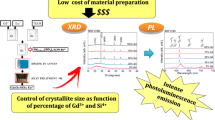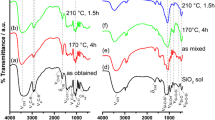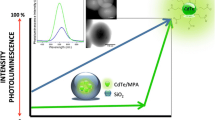Abstract
This work reports on the mechanisms behind the sol–gel synthesis and versatile luminescent behavior of sol–gel silica-based materials based on hexamethoxydisilane (Hexamet) or hexaethoxydisilane (Hexaet) innocuous monomers, at different annealing temperatures. The resulting as-synthesized materials exhibit an intense photoluminescence (PL) band in the blue region of the spectrum, whose maximum shifted in the region of 430–650 nm by applying an annealing process at different temperatures in the range of 350–1,000 °C. This behavior could be attributed to the presence of different silica matrix defect-related luminescent mechanisms. PL emission bands of the Hexamet-derived materials prepared at higher T up to 1,300 °C slightly shifted and appeared in the region of 400–700 nm. However, those Hexaet-derived materials annealed at T between 1,000–1,150 °C showed bands peaking at and above 800 nm, these being related to a quantum confinement effect induced by the presence of silicon nanocrystals (Si_nc) within the polymer matrix. Based on studies carried out by different microscopy and chemical analysis techniques, the origin of the PL behavior was attributed to the kinetics of the hydrolysis and condensation reactions being different for each monomer, which generate different intermediates and eventual structures during the annealing process. The superior tunable luminescent performance of these environmentally-friendly materials provides them with the potential for the fabrication of silicon-based light sources.
Graphical abstract
The superior luminescent performance of SiO2-based materials synthesized by a simple sol–gel process using two different disilane monomers was tuned in a wavelength range from 430 to 860 nm. The mechanisms that appear to govern both the material synthesis and luminescent behaviour are thoroughly described based on results gathered by spectroscopy, microscopy and chemical analyses.













Similar content being viewed by others
References
Canham LT (1990) Silicon quantum wire array fabrication by electrochemical and chemical dissolution of wafers. Appl Phys Lett 57:1046–1048
Dinh LN, Chase LL, Balooch M, Siekhaus WJ, Wooten F (1996) Optical properties of passivated Si nanocrystals and SiOx nanostructures. Phys Rev B 54:5029–5037
Torchynska T, Becerril Espinoza FG, Goldstein Y, Savir E, Jedrzejewski J, Khomenkova L, Korsunska N, Yukhimchuk V (2003) Nature of visible luminescence of co-sputtered Si–SiOx systems. Phys B 340:1119–1123
Chen MJ, Yen JL, Li JY, Chang JF, Tsai SC, Tsai CS (2004) Stimulated emission in a nanostructured silicon pn junction diode using current injection. Appl Phys Lett 84:2163–2165
Dal Negro L, Yi JH, Kimerling LC, Hamel S, Williamson A, Galli G (2006) Light emission efficiency and dynamics in silicon-rich silicon nitride films. Appl Phys Lett 88:183103
Torchynska TV, Vivas Hernandez A, Goldstein Y, Jedrzejewskii J, Sandoval SJ (2006) Photoluminescence of Si or Ge nanocrystallites embedded in silicon oxide. J Non-Crystal Solids 352:1152–1155
Hessel CM, Henderson EJ, Kelly JA, Cavell RG, Sham T-S, Veinot JGC (2008) Origin of luminescence from silicon nanocrystals: a near edge X-ray absorption fine structure (NEXAFS) and X-ray excited optical luminescence (XEOL) study of oxide-embedded and free-standing systems. J Phys Chem C 112:14247–14254
Miska P, Dossot M, Nguyen TD, Grün M, Rinnert H, Vergnat M, Humbert B (2010) Embedded silicon nanocrystals studied by photoluminescence and Raman spectroscopies: exciton and phonon confinement effects. J Phys Chem C 114:17344–17349
Prokes SM (1993) Light emission in thermally oxidized porous silicon—evidence for oxide-related luminescence. Appl Phys Lett 62:3244–3246
Zyubin AS, Glinka YD, Mebel AM, Lin SH, Hwang LP, Chen YT (2002) Red and near-infrared photoluminescence from silica-based nanoscale materials: experimental investigation and quantum-chemical modeling. J Chem Phys 116:281–294
Hill NA, Whaley KB (1995) Size dependence of excitons in silicon nanocrystals. Phys Rev Lett 75:1130–1133
Linnros J, Priolo F, Canham L (1998) Light emission from silicon: progress towards Si-based optoelectronics. In: Proceedings of E-MRS 1998, Elsevier, Amsterdam, 1999
Pavesi L, Dal Negro L, Mazzoleni C, Franzo G, Priolo F (2000) Optical gain in silicon nanocrystals. Nature 408:440–444
Wolkin MV, Jorne J, Fauchet PM, Allan G, Delerue C (1999) Electronic states and luminescence in porous silicon quantum dots: the role of oxygen. Phys Rev Lett 82:197–200
Prokes SM, Glembocki OJ, Bermudez VM, Kaplan R, Friedersdorf LE, Searson PC (1992) Sihx excitation—an alternate mechanism for porous Si photoluminescence. Phys Rev B 45:13788–13791
Brandt MS, Fuchs HD, Stutzmann M, Weber J, Cardona M (1992) The origin of visible luminescence from porous silicon—a new interpretation. Solid State Commun 81:307–312
Schottner G (2001) Hybrid sol–gel-derived polymers: applications of multifunctional materials. Chem Mater 13:3422–3435
Soraru GD, Modena S, Bettotti P, Das G, Mariotto G, Pavesi L (2003) Si nanocrystals obtained through polymer pyrolysis. Appl Phys Lett 83:749–751
Das G, Ferraioli L, Bettotti P, De Angelis F, Mariotto G, Pavesi L, Di Fabrizio E, Soraru GD (2008) Si-nanocrystals/SiO2 thin films obtained by pyrolysis of sol–gel precursors. Thin Solid Films 516:6804–6807
Dian J, Valenta J, Luterova K, Pelant I, Nikl M, Muller D, Grob JJ, Rehspringer JL, Hónerlage B (2000) Optical properties of Si+-ion implanted sol–gel derived SiO2 films. Mater Sci Eng B 69:564–569
Dima A, Della Corte FG, Williams CJ, Watkins KG, Deardena G, O’Hare N, Casalino M, Rendina I, Dima M (2008) Silicon nano-particles in SiO2 sol–gel film for nano-crystal memory device applications. J Microelectron 39:768–770
Rodríguez JA, Fernández-Sánchez C, Domínguez C, Hernández S, Berencén Y (2012) Bulk silica-based luminescent materials by sol–gel processing of non-conventional precursors. Appl Phys Lett 101:171908
Lin G-R, Lin C-J, Yu K-C (2004) Time-resolved photoluminescence and capacitance-voltage analysis of the neutral vacancy defect in silicon implanted SiO2 on silicon substrate. Appl Phys Lett 96:3025–3027
Skuja L (1998) Optically active oxygen-deficiency-related centers in amorphous silicon dioxide. J Non-Cryst Solids 239:16–48
Hinić I, Stanišić G, Popović Z (2003) Influence of the synthesis conditions on the photoluminescence of silica gels. J Serb Chem Soc 68:953–959
Yu Z, Aceves M, Carrillo J, Flores F, Falcony C, Domínguez C, Llobera A, Morales-Acevedo A (2004) Photoluminescence in off-stoichiometric silicon oxide compounds. Superficies y Vacio 17:1–6
Suzuki T, Skuja L, Kajihara K, Hirano M, Kamiya T, Hosono H (2003) Electronic structure of oxygen dangling bond in glassy SiO(2): the role of hyperconjugation. Phys Rev Lett 90:186404
Vaccaro L, Morana A, Radzig V, Cannas M (2011) Bright visible luminescence in silica nanoparticles. J Phys Chem C 115:19476–19481
Lau HW, Tan OK, Liu Y, Ng CY, Chen TP, Pita K, Lu D (2005) Defect-induced photoluminescence from tetraethylorthosilicate thin films containing mechanically milled silicon nanocrystals. J Appl Phys 97:104307
Yi LX, Heitmann J, Scholz R, Zacharias M (2002) Si rings, Si clusters, and Si nanocrystals-different states of ultrathin SiOx layers. Appl Phys Lett 81:4248–4250
Bornhauser P, Calzaferri G (1996) Ring-opening vibrations of spherosiloxanes. J Phys Chem 100:2035–2044
Dohnalová K, Pelant I, Kůsová K, Gilliot P, Gallart M, Crégut O, Rehspringer J-L, Hönerlage B, Ostatnický T, Bakardjeva S (2008) Closely packed luminescent silicon nanocrystals in a distributed-feedback laser cavity. New J Phys 10:063014
Luna-López JA, Carrillo-López J, Aceves-Mijares M, Morales-Sánchez A, Falcony C (2009) FTIR and photoluminescence of annealed silicon rich oxide films. Superficies y Vacío 22:11–14
Pretsch E, Buhlmann P, Badertscher M (2009) Structure determination of organic compounds: tables of spectral data, 4th edn. Springer, Berlin
Wright JD, Sommerdijk NAJM (2000) Advanced chemistry text series. In: Phillips D, O’Brien P, Roberts S (eds) Sol–gel materials chemistry and applications, vol 4. CRC Press, Florida
Atwell WH, Weyenberg DR (1968) Silylene chemistry I. thermolysis of methoxypolysilanes. J Am Chem Soc 90:3438
Gillette GR, Noren GH, West R (1989) Lewis base adducts to diorganosilylenes. Organomet 8:487–491
Atwell WH, Mahone LG, Hayes SF, Uhlmann JG (1969) Silylene chemistry 2. A kinetic study of thermolysis of sym-dimethoxy-tetramethyldisilane. J Organomet Chem 18:69
Zahi I, Mur P, Blaise P, Estève A, Djafari Rouhani M, Vergnes H, Caussat B (2001) Multi-scale modelling of silicon nanocrystal synthesis by low pressure chemical vapor deposition. Thin Solid Films 519:7650–7658
Walsh R (1981) Bond-dissociation energy values in silicon-containing compounds and some of their implications. Acc Chem Res 14:246–252
Salh R (2011) Defect related luminescence in silicon dioxide network: a review in crystalline silicon: properties and uses. In: Basu S (ed). InTech, Open Access Company, Rijeka, Croatia
Daldosso N, Das G, Larcheri S, Mariotto G, Dalba G, Pavesi L, Irrera A, Priolo F, Iacona F, Rocca F (2007) Silicon nanocrystal formation in annealed silicon-rich silicon oxide films prepared by plasma enhanced chemical vapor deposition. J Appl Phys 101:113510
Acknowledgments
Financial support from MINECO-DGI, Project Ref. TEC2010-17274 and CSIC, Project Ref. PIE 200950I197, is acknowledged.
Author information
Authors and Affiliations
Corresponding author
Rights and permissions
About this article
Cite this article
Fernández-Sánchez, C., Rodríguez, J.A. & Domínguez, C. Synthesis of sol–gel SiO2-based materials using alkoxydisilane precursors: mechanisms and luminescence studies. J Sol-Gel Sci Technol 73, 417–427 (2015). https://doi.org/10.1007/s10971-014-3551-x
Received:
Accepted:
Published:
Issue Date:
DOI: https://doi.org/10.1007/s10971-014-3551-x




